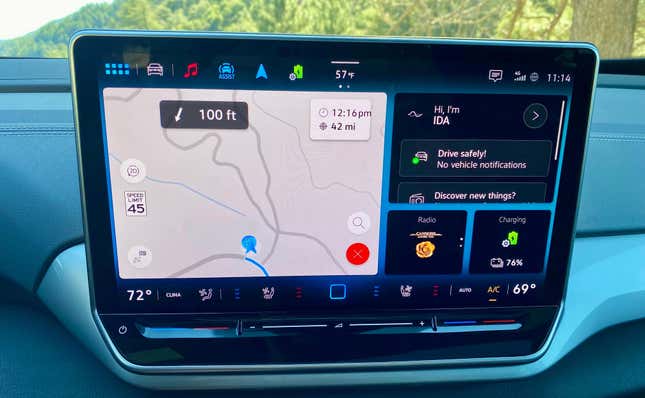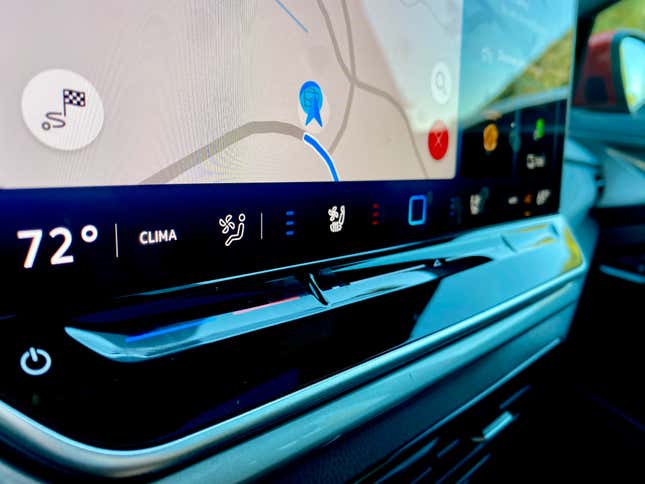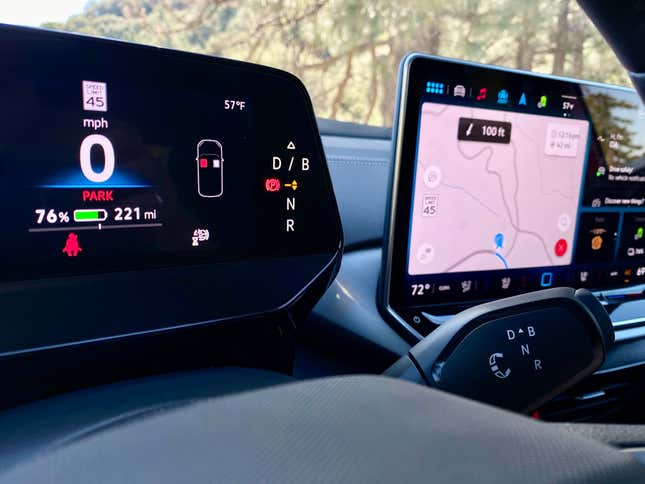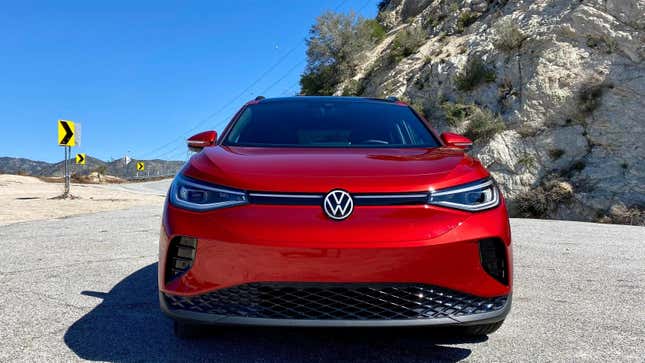When the Volkswagen ID 4 was first introduced, it withstood serious criticism for a variety of reasons, but the one feature that everyone seemed to have a hatred for was its infotainment system, with a special deluxe level of disdain for the car’s unilluminated touch-sensitive climate control and volume sliders.
To address the endless complaints, Volkswagen is updating the ID 4 Pro models with a new infotainment system for 2024, plus more power, more range and a handful of new features. Sadly, these changes are only reserved for the higher-end Pro models of the ID 4 with the larger battery pack, which means the cheaper ID 4 Standard is stuck with the crappy old infotainment, slower motors and less range. So much for being the People’s Car.
Full disclosure: Volkswagen invited me out to Pasadena to drive its newly updated ID 4 on the legendary Angeles Crest Highway. I only got to spend a few hours with the car, so my impressions come from a very short drive that took place during a bright and sunny Los Angeles day.
The ID 4 Pro models are fitted with an 82-kWh battery pack, the same as before, but with a new, more powerful rear drive motor. Rear-wheel-drive ID 4 Pros now have 282 horsepower and 402 pound-feet of torque, up from 201 hp and 229 lb-ft (the numbers that the Standard car still gets). All-wheel-drive ID 4 Pros have 335 hp, a moderate increase from the previous model’s 295 hp, but VW hasn’t released a final torque figure. The new ID 4 Pro AWD can go from 0 to 60 mph in a claimed 4.9 seconds, almost a full second quicker than last year’s best effort.
Driving the updated ID 4 is a pleasant experience. The car I get to pilot and be passenger in is an ID 4 Pro S RWD, the mid-range configuration with the new motor that provides the longest potential maximum range in the lineup at an underwhelming EPA-rated 291 miles, a slight increase from 275 miles in last year’s model. AWD ID 4 Pros get a bump from 255 to 263 miles. I don’t have anywhere near enough time to test the range, but I do get to take it through some of California’s best mountain roads, which is actually kind of fun. The upgraded motor provides ample power and the kind of electric punch I want, when I want it. The steering is devoid of feel and really light, but the rack is quick enough to keep me from tangling my arms when going around hairpins. Considering that the ID 4 is a family crossover, it handles pretty well and feels way more playful than the Chevrolet Blazer EV RS.

There are no drive modes aside from a “B” mode for regenerative braking which only offers one intensity. Though it’s not powerful enough for one-pedal driving, it is a smooth system that does its job well. The actual brake feel is mildly disconcerting, though — it feels like I’m pushing the brake pedal on a car with exceedingly worn brakes. The rear suspension also feels a bit bouncy to me, with more rebound from road imperfections than desired, but it’s not a dealbreaker.
Despite having restructured menus and a larger 12.9-inch screen, the new infotainment system is still unnecessarily convoluted, and the bigger screen doesn’t use its additional space particularly well. Menus take up the entire screen, causing your route guidance to disappear should you want to choose a new radio station or change your climate control settings. A larger screen should mean more space, so I wish VW added some menu pop-outs instead of making every little action require the entire 12.9-inch screen.

I don’t get a proper chance to experience the newly backlit slider controls, which are still mounted directly below the touchscreen. I do go through a few tunnels and overpasses that allow me to see the illumination, but they look disappointingly dim. Maybe that’s for the better so they don’t blind the occupants at night, but I’m not very impressed.
The interior pleasantly muffles wind and road noise, but there’s too much scratchy plastic, especially considering the high prices of upper ID 4 trims. Another change VW made with this update was moving the gear selector from the gauge cluster surround into the right-side steering wheel stalk. Unlike other long bulky gear selector stalks that protrude from steering columns, like what you get in a GM truck, the ID 4’s doesn’t actually move. Instead, it’s a Bop-It style selector where you twist the selector away to select drive and twist it towards you to select reverse. I find it to be weird at first, but it falls close to your hand and an owner will get used to it pretty quickly.

Other new additions include standard 20-inch wheels and optional 21s on S models, available ventilated front seats, and a newly optional Harman Kardon sound system with nine speakers, an amp and a sub that my test car sadly doesn’t have.
For 2024 the ID 4 receives a price increase too, so the cheapest new ID 4 you can buy now costs $41,160 after destination. A Pro S RWD like I drove passes the $45k mark, while the base price of the highest trim level, the Pro S Plus AWD, starts at over $58,000, which is a huge sum of money, though it thankfully is eligible for the full federal EV tax credit. The 2024 ID 4’s increased power is fun, its improved tech is a glacial crawl in the right direction, and the better range should ease nervous EV adopters. It’s just a shame the ID 4’s upgrades are limited to the pricier versions.



